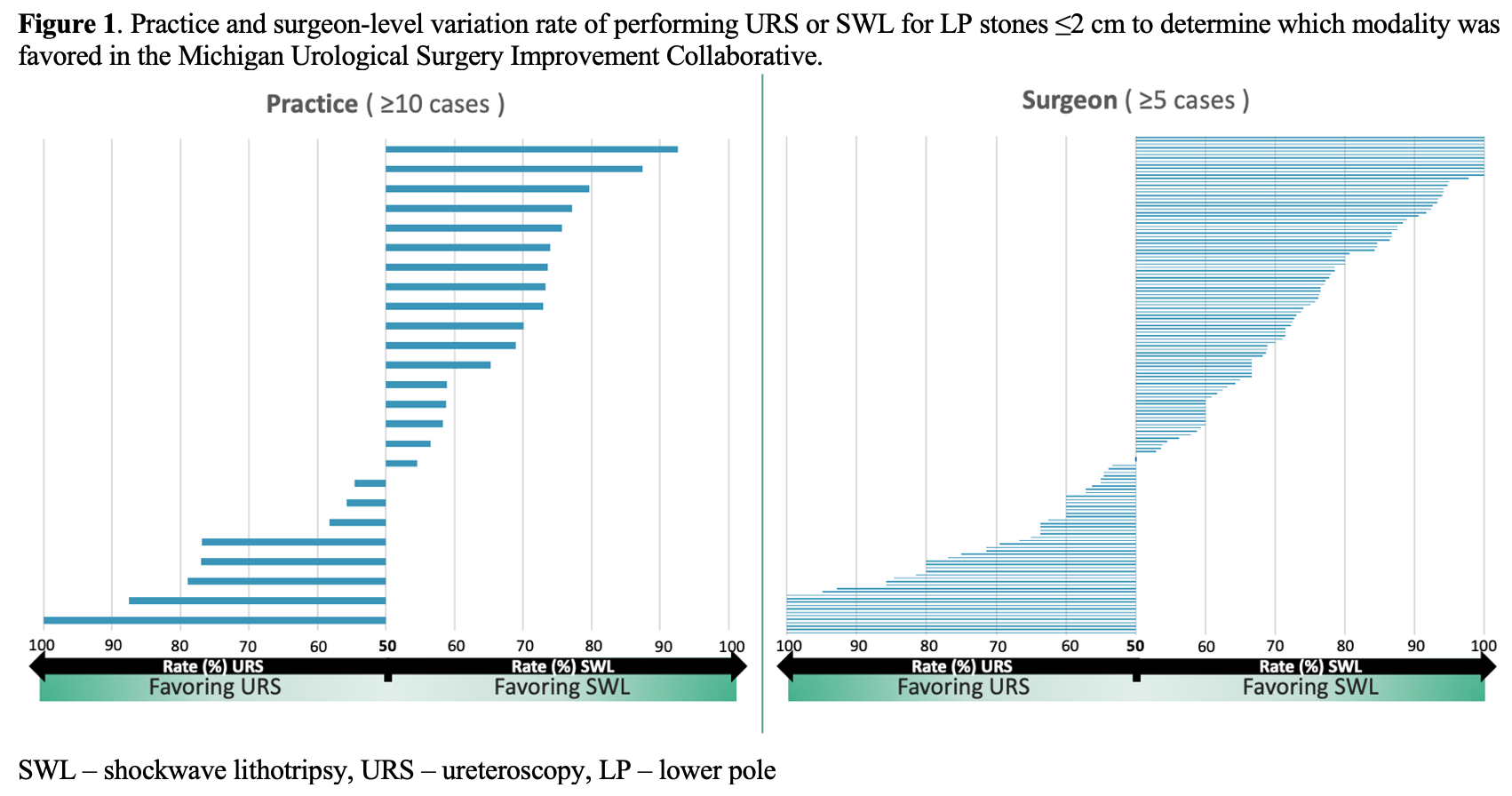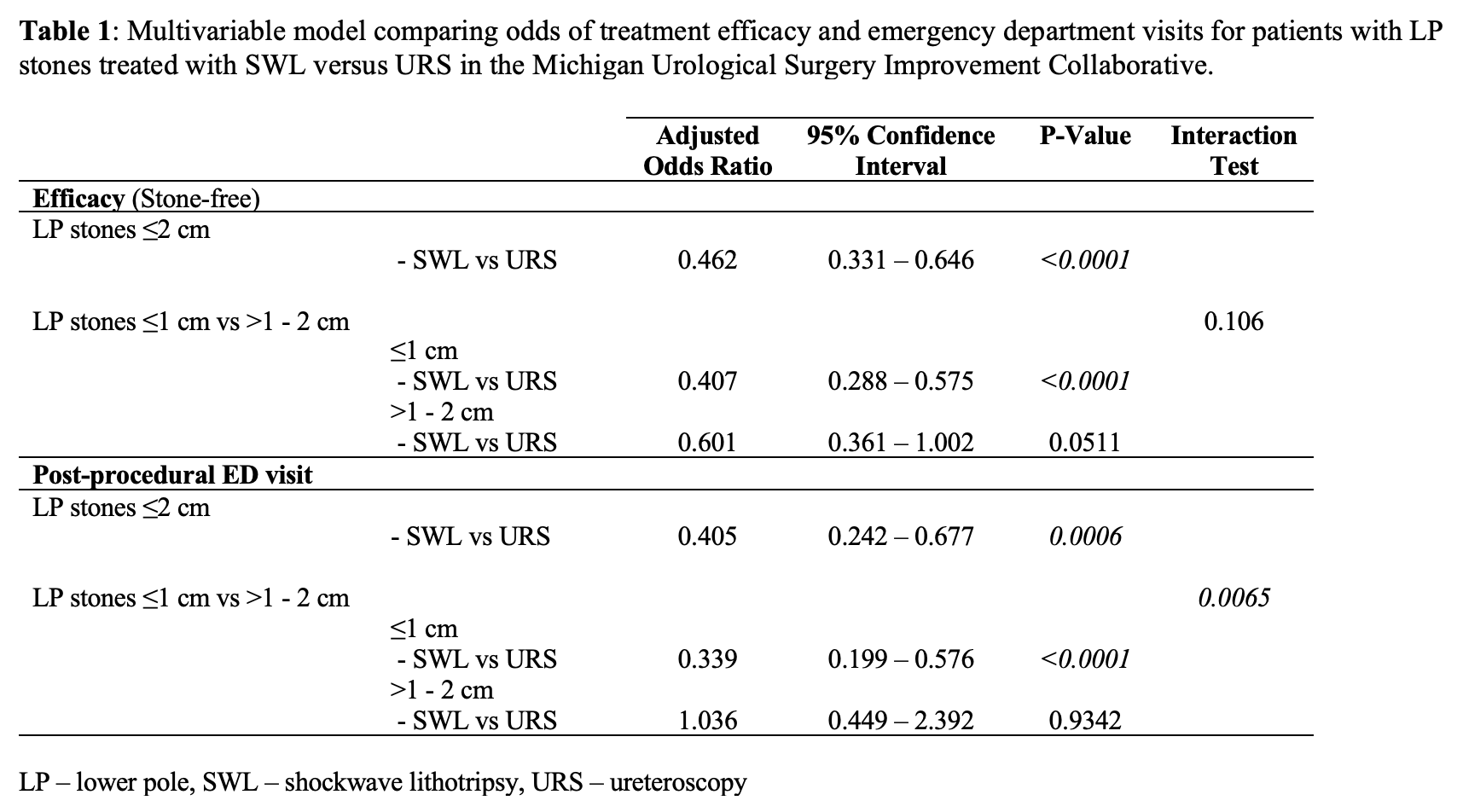Back
Poster, Podium & Video Sessions
Moderated Poster
MP44: Stone Disease: Surgical Therapy (including ESWL) III
MP44-11: Ureteroscopy vs. shockwave lithotripsy for lower pole renal stones: Treatment variation and outcomes in a surgical collaborative
Sunday, May 15, 2022
1:00 PM – 2:15 PM
Location: Room 228
John Michael DiBianco*, Stephanie Daignault-Newton, Ann Arbor, MI, Eric Stockall, Lansing, MI, Spencer Hiller, Hyung Joon Kim, Ann Arbor, MI, Hector Pimentel, Grand Rapids, MI, Casey A. Dauw, Khurshid R. Ghani, for the Michigan Urological Surgery Improvement Collaborative, Ann Arbor, MI
.jpg)
John M. Dibianco, MD
University of Michigan
Poster Presenter(s)
Introduction: American Urological Association guidelines recommend ureteroscopy (URS) or shockwave lithotripsy (SWL) for lower pole (LP) renal stones =1cm, and URS for stones >1-2cm. However, data guiding these recommendations are from select centers. We examined treatment variation, unplanned healthcare utilization and stone-free rates (SFR) in the diverse practices comprising the Michigan Urological Surgery Improvement Collaborative (MUSIC).
Methods: Using the MUSIC registry we identified URS and SWL cases for LP stones =2cm from 2016-2021. We assessed practice and surgeon frequency of performing URS or SWL. A treatment modality was considered favored if the procedure rate was >50%. Emergency department (ED) visits, hospitalization and SFRs were assessed according to stone size (=1, >1-2cm).
Results: 3,645 procedures were performed across 35 practices and 209 surgeons; 1358 (37.3%) URS and 2287 (62.7%) SWL. 80.2% of stones were =1cm. There was practice variation in performing URS (0 to 100%; p<0.001) and SWL (0 to 100%; p<0.001). 74.2% of surgeons favored SWL; 10% performed SWL, and 5.7% URS exclusively (Figure). For stones =1cm, ED visits (9.5% vs 2.5%, p<0.001) and hospitalizations (3.5% vs 0.4%, p<0.001) were higher after URS, as were SFRs (URS 56.4% vs SWL 38.8%; p<0.001). There were no significant differences between URS and SWL for ED visits, hospitalizations, or SFRs, for >1-2cm stones. Multivariable analysis revealed significantly increased odd of having an ED visit and being stone-free for all LP stones =2cm and =1cm treated with URS (Table).
Conclusions: In Michigan, SWL is the favored treatment modality for LP stones =2cm. Over 15% of surgeons used one modality exclusively. URS provided better SFRs but with a 4-fold increase in ED visits and hospitalization for stones =1cm but no difference for >1-2cm stones. Our findings demonstrate the need for quality efforts to address treatment selection and improve outcomes.
Source of Funding: Blue Cross Blue Shield of Michigan


Methods: Using the MUSIC registry we identified URS and SWL cases for LP stones =2cm from 2016-2021. We assessed practice and surgeon frequency of performing URS or SWL. A treatment modality was considered favored if the procedure rate was >50%. Emergency department (ED) visits, hospitalization and SFRs were assessed according to stone size (=1, >1-2cm).
Results: 3,645 procedures were performed across 35 practices and 209 surgeons; 1358 (37.3%) URS and 2287 (62.7%) SWL. 80.2% of stones were =1cm. There was practice variation in performing URS (0 to 100%; p<0.001) and SWL (0 to 100%; p<0.001). 74.2% of surgeons favored SWL; 10% performed SWL, and 5.7% URS exclusively (Figure). For stones =1cm, ED visits (9.5% vs 2.5%, p<0.001) and hospitalizations (3.5% vs 0.4%, p<0.001) were higher after URS, as were SFRs (URS 56.4% vs SWL 38.8%; p<0.001). There were no significant differences between URS and SWL for ED visits, hospitalizations, or SFRs, for >1-2cm stones. Multivariable analysis revealed significantly increased odd of having an ED visit and being stone-free for all LP stones =2cm and =1cm treated with URS (Table).
Conclusions: In Michigan, SWL is the favored treatment modality for LP stones =2cm. Over 15% of surgeons used one modality exclusively. URS provided better SFRs but with a 4-fold increase in ED visits and hospitalization for stones =1cm but no difference for >1-2cm stones. Our findings demonstrate the need for quality efforts to address treatment selection and improve outcomes.
Source of Funding: Blue Cross Blue Shield of Michigan



.jpg)
.jpg)